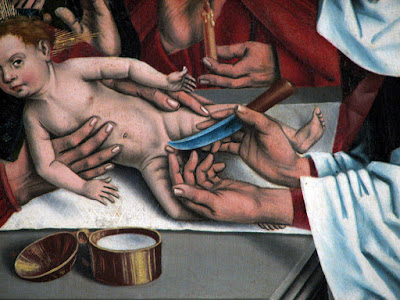Relics were the conspiracy theories of the middle ages. They were actively traded and monetised; they brought wealth and prestige to the churches and abbeys that housed them. They were engines of economic growth. Beyond the mundane bits of bone and fragments of the true cross, there were many more outlandish ones including milk from the breast of the Virgin Mary, along with her belt that she inadvertently left behind when she ascended into heaven. There was also the manger that the baby Jesus was placed in and the lance that pierced his side. Possibly the most peculiar relic, and the one that my conspiracy theory revolves around, is the Sancta Prepuce, or the foreskin of Jesus. Jesus, born a Jew, would have been circumcised 8 days after birth.
December 25, in the year 800, Charlemagne, King of the Frankish kingdoms, was crowned Emperor of the Romans by Pope Leo III in St Peter's in Rome. Among the gifts Charlemagne gave to Pope Leo was a small alabaster box that contained, preserved in oil, the foreskin of Jesus. Where Charlemagne acquired this peculiar item is not known, but once in his possession, Leo III placed it in his private chapel in the medieval Lateran Palace, the Sancta Sanctorum, with other priceless relics and there it stayed for the following 700 years. During the Sack of Rome in 1527 it was looted. Later that year, a German mercenary was captured in Calcata with the precious relic which was then transferred to the village church.
Calcata is an ancient medieval town perched precariously atop volcanic cliffs 47 km north of Rome. With the foreskin now housed in its church, it became a popular pilgrimage destination complete with a 10 year indulgence offered to pilgrims who made the trek there. Each year on January 1st, the Feast of the Holy Circumcision, the relic was paraded around town. Until 1983. That is when he parish priest Dario Magnoni announced to the village that the Sancta Prepuce had vanished. Stolen. Gone. But no police report was ever filed.
For most of the preceding century, the Papal authority had questioned and sought to suppress the veracity of the Holy Foreskin. By 1900 citing "irreverent curiosity", the importance of the relic was downplayed,. Soon after, even mentioning the Sancta Prepuce could lead to excommunication. In 1960 as part of Pope John XXIII's liturgical calendar revisions, January 1st was renamed the Octave of the Nativity, no longer explicitly mentioning the circumcision. In 1969 the name was changed again to the Feast of the Solemnity of Mary, effectively erasing the connection to the foreskin. But still, Calcata persisted.
So why did this tradition which spanned hundreds of years come to an abrupt end in 1983?
Here is my Q-anon worthy theory. In the 1970's a rapid sequencing technique for DNA was developed. By the early 1980's this technology was established and reputable enough to be used in court cases to secure a conviction. In 1982 Delacorte Press published a book by Michael Baigent, Richard Leigh and Henry Lincoln, which became a New York Times best seller. The book, Holy Blood, Holy Grail, put forth the idea of a bloodline of Jesus and Mary Magdalene. It is an idea that Dan Brown would later employ as the storyline for his explosive and phenomenally popular book, The DaVinci Code.
Now there was the real possibility that Christianity could be brought to its knees - if the DNA of the Sancta Prepuce could be sequenced and a bloodline of Jesus could be identified, that would throw into doubt the divinity and divine origins of Christ. All would collapse like a house of cards. The Vatican had to act, and act fast. The wealth, power and prestige of the Church was threatened. The ancient relic was made to disappear.
Today Calcata is a quirky quiet little village, still clinging to the rocky outcropping. In 2015, I decided to post drawings of prepuce around the town in homage to its past.








No comments:
Post a Comment